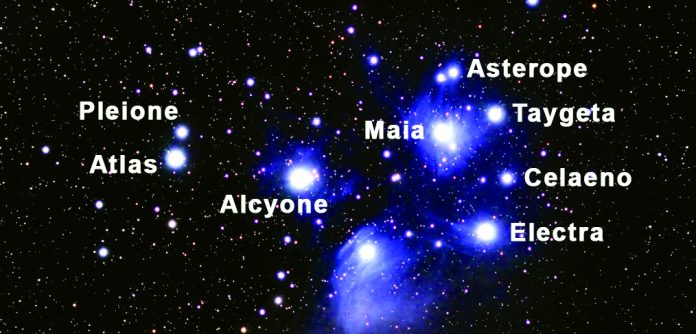Matariki
Matariki is the Māori name for the Pleiades constellation, and according to Alan Gilmore, recently retired Superintendent of Mt. John University Observatory, Physics and Astronomy Department, University of Canterbury, the Matariki/Pleiades cluster is visible on a ‘dawn sea horizon’ from June 14 each year, or a few days later if clouds, moonlight or haze make it less visible on that actual date.
Matariki in the East vs Puanga in the West
The arrival of Matariki is not, as it is sometimes suggested, the specific beginning of the new Māori ‘calendar’ year, but simply heralds the new season arriving, at about the same time the new Māori lunar year commences.
For the tribes in the East of Aotearoa (Land of the long white cloud, or New Zealand), observation of Matariki rising over a period of a week or two, from 14 June onwards, provides additional visual information (conditional on the haze, or clarity), on which to further predict the coming years’ potential outcomes regarding foraging, harvests, hunting and fishing. That is the purpose for observing Matariki over that period.
As tribes in West Aotearoa have no visibility of the eastern sea horizon, they cannot observe the rising of Matariki, but instead, they seek to observe Puanga, or ‘Rigel’ in the constellation of ‘Orion’ to herald the coming of the new Māori lunar year.
The sun and moon working together
The solstice marks the beginning of the new solar season (winter or summer), but the actual start date of the Māori lunar year depends on the phase of the moon.
The day following the ‘new moon’ (Whiro) falling on or prior to the winter solstice (June 21-23), will mark the actual beginning of the new Māori lunar calendar, for that coming year. The first month of each lunar year is named Pipiri.
In 2016, Pipiri commenced on 6 June, meaning that when you list the lunar months for the 2016 lunar year, there are 12 lunar months. However, in 2017 Pipiri will commence on 27 May, and then 13 lunar months will follow, until Pipiri starts once again on 15 June 2018, and then 12 lunar months will follow.
Thirteen months in a year
Lunisolar calendars are problematic in that the time from ‘new moon’ (Whiro) to new moon is 29.53 days while a solar year is 365.24 days long, so there are 12.37 lunar months in a solar year. Therefore, an extra lunar month has to be added every two or three years, to keep the lunar months in time with the sun and the seasons.
The name of the thirteenth Māori month for some tribes is ‘Whiringa- kerekere’ (or ‘Hiringa-kerekere’) and when it occurs, is slotted in between the months ‘Whiringa-ā-rangi’ and ‘Hakihea’, and usually expected during November.
Folklore
Lunar phases and night-time have esoteric importance in the Māori world. Night is the time that deities or ancestral spirits, patupaiarehe, or tūrehu (different names for fair folk) are believed to be at their most powerful. It is for this reason that the majority of Māori ceremonies are held just before dawn, and because dawn brings with it new life.
Lunar cycles of life
The location of tribes in Aotearoa determined which nature cycles were most relevant for those people. For example, if you were a sea-faring or fisher people, understanding how the moon controls tides was important, but this knowledge was less important if you lived inland.
According to common wisdom and practice around the world (particularly in past times), the lunar calendar was used as a reliable predictor of the best times to plant, harvest, fish, gather and carry out all sorts of other survival and societal activities. The meanings behind the Māori names of the months also refer to these lunar cycles of life.
Thanks to the kind assistance of Māori scholars Jack Thatcher and Awanuiārangi Black (deceased), together with Alan Gilmore of University of Canterbury (retired), for the factual basis of this article.
By Antoon Moonen






































































